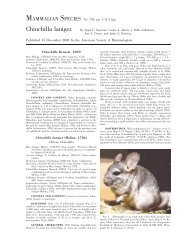Galictis vittata
Galictis vittata
Galictis vittata
You also want an ePaper? Increase the reach of your titles
YUMPU automatically turns print PDFs into web optimized ePapers that Google loves.
2 MAMMALIAN SPECIES 727—<strong>Galictis</strong> <strong>vittata</strong><br />
FIG. 3. Distribution of <strong>Galictis</strong> <strong>vittata</strong> in Central and South<br />
America based on localities in Anderson (1997), Bisbal (1989),<br />
Eisenberg and Redford (1999), Krumbiegel (1942), Leopold (1959),<br />
Lönnberg (1921), Marineros and Martínez Gallegos (1998), Massoia<br />
et al. (1985), McCarthy et al. (1991), and Redford and Eisenberg<br />
(1992) and specimens in American Museum of Natural History,<br />
Field Museum of Natural History, Museu Goeldi, and National Museum<br />
of Natural History. Type localities are indicated with an asterisk:<br />
1, G. v. andina; 2,G. v. brasiliensis; 3,G. v. canaster; and<br />
4, G. v. <strong>vittata</strong>. The type locality of G. v. <strong>vittata</strong> is Surinam; thus,<br />
location of the triangle in Surinam is arbitrary. Subspecies limits<br />
are not known.<br />
FIG. 2. Dorsal, ventral, and lateral views of cranium and lateral<br />
view of mandible of adult male <strong>Galictis</strong> <strong>vittata</strong> (Field Museum<br />
of Natural History 98231), Yarincocha, Loreto Department, Peru.<br />
Condylobasal length of skull is 97.9 mm.<br />
1841; Dalquest and Roberts 1951). Vibrissae are black (Mendez<br />
1970).<br />
Top of head, back, sides, and tail are grizzled grayish ‘‘salt<br />
and pepper’’ due to black guard hairs with white tips. Face, throat,<br />
belly, and legs are usually solid black but sometimes grizzled. A<br />
diagonal white or cream, narrow stripe runs from forehead to shoulder<br />
and separates dorsal gray from ventral black. Dorsal and ventral<br />
colors are usually clearly demarcated, but this is variable. Fur is<br />
coarse (Dalquest and Roberts 1951), but undercoat is soft and short<br />
(Bell 1841).<br />
Skull (Fig. 2) is strong, massive, and low with a broad, rounded<br />
‘‘v’’-shaped braincase (Goodwin 1969) and a short rostrum<br />
(Nehring 1886). Dorsal profile of skull is relatively flat, postorbital<br />
processes are short and pointed, zygomatic arches are strongly developed,<br />
and bullae are flattened (Goodwin 1969). Palate is broad<br />
compared with length of head and extends posteriorly to a point<br />
about even with widest part of zygomatic arch. Teeth are large and<br />
strong. M1 is transverse, about twice as wide as long, and with a<br />
lobe-shaped cingulum (Goodwin 1969; Langguth and Anderson<br />
1980). A distinct metaconid is present on m1, and a larger cingulum<br />
is found on inner side of P3. Tail has 17–18 vertebrae (Husson<br />
1978). Sexes are similar, but females are smaller, more slender,<br />
and lighter (Dalquest and Roberts 1951; Leopold 1959).<br />
Dorsum of G. v. <strong>vittata</strong> is dark brown or yellow-gray with<br />
white- or yellow-tipped hairs, whereas dorsum is purer gray in G.<br />
v. canaster due to light gray undercoat and guard hairs with light<br />
gray basal half; broad, black subterminal bands; and small white<br />
tips (Nelson 1901). G. v. andinum has a dull yellowish stripe on<br />
head, and tips of dorsal hairs are yellowish, whereas they are offwhite<br />
in G. v. brasiliensis (Krumbiegel 1942; Thomas 1903). In<br />
specimens we have observed, these differences are subtle but clearly<br />
present.<br />
Published measurements are for small sample sizes (Anderson<br />
1997; Goodwin 1946; Husson 1978; Ihering 1910; Krumbiegel<br />
1942; Mares et al. 1989; McCarthy et al. 1991; Nehring 1886) or<br />
ranges of external measurements of unknown sample sizes (Eisenberg<br />
1989; Hall 1981; Herter 1975). We supplement these with<br />
measurements of specimens in the American Museum of Natural<br />
History, Field Museum of Natural History, National Museum of Natural<br />
History, and Museu Goeldi. External measurements were recorded<br />
from specimen tags; cranial measurements follow Cockrum<br />
(1955). Nearly equal numbers of males and females were available<br />
for most measurements; only specimens with teeth fully erupted<br />
were measured. Measurements (in mm) were mean SD (range,<br />
n): total length, 676.2 46.9 (600–760, 19); length of tail, 157.4<br />
15.2 (135–195, 19); length of head and body, 518.8 40.2<br />
(450–600, 19); length of hind foot, 82.8 8.8 (66–97, 18); length<br />
of ear, 25.8 3.5 (20–32, 11); basilar length of Hensel, 80.15 <br />
5.25 (71.5–96.5, 27); condylobasilar length, 88.17 4.72 (80.3–<br />
97.9, 35); palatilar length, 41.88 2.68 (38.0–45.5, 20); postpalatal<br />
length, 39.29 1.84 (37.1–42.8, 13); length of maxillary<br />
toothrow, 28.04 3.13 (23.1–32.5, 28); zygomatic breadth, 50.98<br />
3.21 (45.4–56.2, 32); mastoid breadth, 47.87 2.86 (42.9–54.4,<br />
30); squamosal breadth, 40.79 1.85 (37.8–43.0, 14); postorbital<br />
breadth, 19.79 1.22 (17.8–22.2, 32); least interorbital breadth,
















